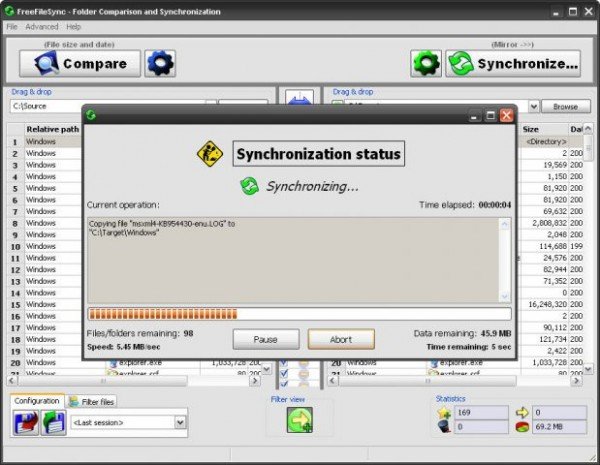
- Freefilesync command line pause how to#
- Freefilesync command line pause update#
- Freefilesync command line pause portable#
- Freefilesync command line pause Pc#
- Freefilesync command line pause download#
If you still need help, select Contact Support to be routed to the best support option.Īdmins should view Help for OneDrive Admins, the OneDrive Tech Community or contact Microsoft 365 for business support. OneDrive is stuck on Processing changes Need more help?įor help with your Microsoft account and subscriptions, visit Account & Billing Help.įor technical support, go to Contact Microsoft Support, enter your problem and select Get Help. In the activity center, select or the yellow box to get going again: Select the paused OneDrive icon in the notification/menu area: Syncing will resume automatically after the Pause time has finished, or you can manually Resume syncing at any time. If you have both OneDrive and OneDrive for Business, you can pause and resume them independently.
Freefilesync command line pause Pc#
OneDrive will automatically pause when your PC enters battery saver mode, or you are connected to a metered network. The Advanced tab also lets you do things like run it as a different user, assign a keyboard shortcut that immediately launches it, lots of cool stuff.If you don't see the OneDrive cloud on your taskbar or menubar, read I can't see any OneDrive icons. If you need to see the output it gives, you can also check "Run in terminal" from the Advanced tab, which opens a terminal and runs it in that whenever you run it from the start menu, which can help if you're having problems and need to see what it's saying. You may receive a User Access Control (UAC) prompt about allowing it to make changes to your computer, if so click Yes to continue.
To install, double-click the installer EXE after downloading it. It'll auto-fill the command field with a path to the binary. FreeFileSync is a free and open-source tool designed to manage file synchronisation.
Freefilesync command line pause portable#
This should work fine with the portable version. To select the actual application to run, you can click on the folder icon to the right of the "Command" field, and select the executable you want it to open. FreeFileSync enables additional synchronization scenarios via acommand line interface. You can select the category, give it a name and description/comment, assign an icon, etc. Right-clicking on the application launcher has a context menu option labelled "Edit Applications." where you can manually add new entries. KDE lets you create custom start menu entries through the UI pretty simply. So the guide at the end seems to be essentially listing creating a desktop entry for it manually but it's also kind of needlessly complex and goes through a lot of unnecessary hoops.
Freefilesync command line pause how to#
png ~/.local/share/icons/hicolor/256x256/apps/Ĭat > ~/.local/share/applications/sktop ~/.local/share/applications/sktop > ~/.bashrcĮcho "PATH=$PATH:$HOME/Software/FreeFileSync" > ~/.profileīut I haven't any idea how to understand this guide, can someone help me interpret what it's saying? Mkdir -p ~/.local/share/icons/hicolor/256x256/apps/ Unzip Resources.zip FreeFileSync.png RealTimeSync.png # if it don't work - click on "Download FreeFileSync 10.3 Linux 64-bit"
Freefilesync command line pause download#
Create ~/Software folder and download here
Freefilesync command line pause update#
Sudo apt update And now I have found this guide from an Ubuntu forum post (Located here: ) Sudo sudo add-apt-repository -r ppa: eugenesan/ppa Ubuntu 18.04.2 LTS UPDATE::: Okay so, I uninstalled FreeFileSync (and by extension, RealTimeSync) and uninstalled the repository which the original guide I linked gave. I can run RealTimeSync from the terminal, just not through KDE for some reason, and I need to be able to run it through KDE in order to give it file association, from what I can tell. If I open FreeFileSync normally, by typing it into the start menu, I have no issue with it However RealTimeSync shows up in the start menu, but brings up an error "KDE could not find this program" if I try to run it. public IP addresses or hostnames, account numbers, email addresses) before posting!ĭoes this sidebar need an addition or correction? Tell me hereīecause downloading from the freefilesync website gives you a portable installation, and I specifically want to be able to access it from the start menu by typing. Note: ensure to redact or obfuscate all confidential or identifying information (eg. If you fix the problem yourself, please post your solution, so that others can also learn. ✻ Smokey says: dispose of oil, chemicals, whitegoods and electronics correctly to fight climate change! You’d start Quickbooks using the custom batch file and then (in theory), when Quickbooks exits, the batch file you started Quickbooks with would go on to run the FreeFileSync batch job.

If you're posting for help, please include the following details, so that we can help you more efficiently: Also, you may be able to write a command-line batch file that starts Quickbooks and then starts the FreeFileSync Quickbooks data batch job. Any distro, any platform! Explicitly noob-friendly.


 0 kommentar(er)
0 kommentar(er)
